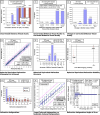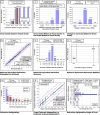Retrospective Study Comparing Topography-Guided and Wavefront-Optimized LASIK Procedures in a Single Center
- PMID: 38860117
- PMCID: PMC11164091
- DOI: 10.2147/OPTH.S455262
Retrospective Study Comparing Topography-Guided and Wavefront-Optimized LASIK Procedures in a Single Center
Abstract
Purpose: To compare visual outcomes of eyes that had laser refractive surgery with the Contoura Phorcides treatment plan and eyes that had laser refractive surgery with the wavefront-optimized treatment plan using the same laser.
Methods: Retrospective chart review of clinical outcomes of eyes that had either Contoura with Phorcides (CP) or wavefront-optimized (WFO) corneal refractive procedures using the Wavelight EX500 (Alcon Vision, LLC). Data were collected and compared for uncorrected distance visual acuity (UDVA), corrected distance visual acuity (CDVA), refraction, change in postoperative UDVA compared to preoperative CDVA, and change in postoperative CDVA compared to preoperative CDVA.
Results: Total eyes included were 348, with 227 in the CP Group and 121 in the WFO Group. Post-operatively, there was a significantly higher percentage of eyes in the CP Group that were 20/16 or better compared to the WFO Group (57%, 129 eyes, and 17%, 21 eyes, respectively; p < 0.001). The percentage of eyes that gained 1 or more Snellen lines of UDVA compared to preoperative CDVA was higher in the CP Group (47%; 107 eyes) compared to the WFO Group (12%; 14 eyes), which was statistically significant (p < 0.001). Differences in refraction were statistically significant.
Conclusion: Topography-guided and wavefront-optimized treatment profiles both provided excellent refractive results. A higher percentage of eyes that were treated using Contoura with Phorcides achieved 20/16 or better unaided distance vision compared to eyes receiving a wavefront-optimized treatment plan.
Keywords: Contoura; Phorcides; topography-guided LASIK; wavefront-optimized LASIK.
Plain language summary
Laser in situ keratomileusis (LASIK) is a common procedure performed to reshape the cornea (transparent part of the eye) and provide clear, spectacle-free vision. There are many different technologies available for surgeons to choose a treatment plan. One of the most popular is called wavefront-optimized LASIK (WFO), which takes into account the curvature of the cornea. Recently, topography-guided LASIK treatment plans that incorporate a proprietary planning software (Contoura Phorcides) have been available that can factor in the individualized surface elevation characteristics of the cornea. The purpose of this study was to compare visual outcomes in patients that had LASIK with the Contoura Phorcides treatment plan to patients that had LASIK with the WFO treatment plan. The results of this study suggest that both treatment profiles both provided excellent refractive results. In addition, a higher percentage of eyes that were treated using Contoura with Phorcides achieved 20/16 or better unaided distance vision compared to eyes receiving a WFO treatment plan.
© 2024 Rowen et al.
Conflict of interest statement
Brad Hall reports that he has received consulting fees from Ace Vision Group outside of the submitted work. Sheri Rowen is a consultant for Alcon, and the following companies outside the submitted work: Ace Vision Group, Azura, Abbvie, Bausch & Lomb, Centricity, iVIZIA, Glia, Kala, Johnson & Johnson, Orasis, RxSight, Science Based Health, Sight Sciences, Stuart Pharma, Tarsus, Viatris, Visus, Zeiss. The authors report no other conflict of interest for this work.
Figures



Similar articles
-
Comparison of refractive and visual acuity results after Contoura® Vision topography-guided LASIK planned with the Phorcides Analytic Engine to results after wavefront-optimized LASIK in eyes with oblique astigmatism.PLoS One. 2022 Dec 19;17(12):e0279357. doi: 10.1371/journal.pone.0279357. eCollection 2022. PLoS One. 2022. PMID: 36534673 Free PMC article.
-
Comparative analysis of outcomes following topography-guided laser in situ keratomileusis using manifest refraction versus a new topographic analysis algorithm.Indian J Ophthalmol. 2023 Jun;71(6):2430-2435. doi: 10.4103/IJO.IJO_226_23. Indian J Ophthalmol. 2023. PMID: 37322655 Free PMC article. Clinical Trial.
-
Topography-guided versus wavefront-optimized laser in situ keratomileusis for myopia: Surgical outcomes.J Cataract Refract Surg. 2019 Jul;45(7):959-965. doi: 10.1016/j.jcrs.2019.01.031. Epub 2019 Jun 10. J Cataract Refract Surg. 2019. PMID: 31196580
-
Femtosecond laser-assisted in situ keratomileusis with topography-guided or asphericity-adjusted derived data: a comparative contralateral eye study.BMC Ophthalmol. 2022 Apr 25;22(1):189. doi: 10.1186/s12886-022-02407-w. BMC Ophthalmol. 2022. PMID: 35468752 Free PMC article. Clinical Trial.
-
Meta-analysis of wavefront-guided vs. wavefront-optimized LASIK for myopia.Optom Vis Sci. 2011 Dec;88(12):1463-9. doi: 10.1097/OPX.0b013e3182333a50. Optom Vis Sci. 2011. PMID: 21946784 Review.
Cited by
-
Comparison of Zeiss MEL90 and Alcon WaveLight EX500 Excimer Lasers in FDA Premarket Approval Trials for the Treatment of Myopia, Hyperopia, and Mixed Astigmatism.J Clin Med. 2025 Jul 31;14(15):5403. doi: 10.3390/jcm14155403. J Clin Med. 2025. PMID: 40807023 Free PMC article.
-
The Efficiency, Predictability and Safety Between Custom-Q Femotsecond Laser In Situ Keratomileusis and Second (Visumax 800) Generation Keratorefractive Lenticule Extraction Surgery.Diagnostics (Basel). 2025 Mar 5;15(5):634. doi: 10.3390/diagnostics15050634. Diagnostics (Basel). 2025. PMID: 40075880 Free PMC article.
References
LinkOut - more resources
Full Text Sources
Miscellaneous

